Karnataka 2nd PUC Biology Notes Chapter 7 Molecular
Life is defined as a dynamic System of co-ordinated chemical physical and biological activities, capable of performing certain functions like metabolism, growth or reproduction.
The origin of life for the first time on earth is called protobiogeneses or Biopioeses.
There are different theories put forward to explain the origin of life. They are as follows:
![]()
1. Theory of special creation or Genesis:
According to this theory, all living beings on this earth were originally created by God or some Supernatural power.
2. Cosmozoic theory or panspermia theory:
It was put forth by Richter, which believes that life on earth has come from a distant planet in the form of spores or microorganisms called cosmozoa or panspermia.
3. Theory of Abiogenesis or spontaneous generation : This theory was proposed by Von Helmount. According to this theory, life originated suddenly and spontaneously from non-living things or decaying organic matter. This was a popular and accepted theory upto 17th century. The Greek philosopher Aristotle was the greatest supporter of this theory.
He believed that fishes, mice, toads, snakes arise spontaneously from mud of the ponds and insects originae from decaying meat (1668). This theory was first disproved by Francisco Redi and later by Spallanzani and Louis Pasteur (Father of Microbiology). Pasteur conducted the Swan-necked Flask experiment to disprove the theory of Abiogenesis. Today this theoiy is discarded totally.
4. Theory of Biogenesis: According to this theory, life arises or originates only from pre-existing life by reproduction. Francisco Redi was the founder of the theory and was supported by Spallanzani, Louis Pasteur and others. They conducted experiments which clearly disproved the theory of Biogenesis. This theory is not accepted as it only explains the continuity of life but not the origin of life.
5. Theory 6f chemical evolution or Materialistic theory or Physicochemical theory or Naturalistic theory: This is the modem concept of origin of life. This theoiy was proposed by a Russian scientist A. J. Oparin (1924) who is the author of the book “Origin of life on earth” (1936). This theory was supported by J.B.S Haldane (Scotlish physiological who later became on Indian citizen). Stanley Miller, Harold Urey, Sydney Fox, etc.
![]()
According to this theory, “Life originated from chemical substances through a gradual process of change under the influence of reducing atmosphere’ (absence of free molecular oxygen in the primitive earth).
There are several theories to explain the origin of solar system. Among these Dust and Cloud Hypothesis or Nebula hypothesis is the most accepted one. According to this hypothesis.
→ About 10,000 – 20,000 years ago, there was a highly condensed mass of cosmic material.
→ This mass of cosmic material exploded to form numerous pieces of cosmic material called nebulae. This explosion of cosmic material is called Big Bang. Hence the theory is also called as the Big Bang Theory.
→ One of such nebulae led to the origin of our solar system. Nebula is defined as a cold cloudy mass of dust and gases containing free atoms.
→ Our solar system was formed about 4,600 million years ago from a hot revolving ball of gas. This gas contained several free atoms of which hydrogen atom was more abundant. The Sun was formed first, when hydrogen atom pulled or gravitated towards the centre of the ball. Outside this newly formed Sun were many revolving belts of gases. Subsequently these belts broke up into several smaller separate hot revolving spheres which were the earliest planets, one among them was the Earth.
→ The Earth is supposed to have originated about 4,500 – 5,000 million years ago. The early Earth was a hot burning mass of gases with free atoms of vapours of various elements like H, O, and N the heavier metallic atoms like iron, nickel, copper etc formed the solid core or centre of the Earth. Medium weight atoms like sodium K, Si, Al, Mg, S etc formed a shell (future lithosphere) around the core and the lightest atoms like Helium, H, O, Argon, C, N, etc., formed the outermost sphere-atmoshpere.
→ The original temperature of the Earth was very high (5000°-6000°C), and it did not permit the formation of chemical bonds between these elements and hence they remained in the form of atoms only (because the heat destroyed the bonds) . As eons passed, Earth started cooling and as a result, some hot gases were liquefied and some liquid gases became solids. The centre of the Earth still contains a hot liquid in the form of lava but the middle layers solidified to from earth’s crust.
→ The earth’s crust cooled and became wrinkled and folded (with elevations and depressions) to form mountains and valleys. The outermost layer remained in the gaseous state to form the atmosphere. This was the beginning of the chemical history of the earth.
→ Hydrogen being active and abundant readily combined with C, N, O to form simple inorganic compound like
(a)
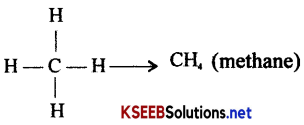
(b)

(c) H — H → H2 (molecular hydrogen)
(d) H – C ≡ N → HCN (Hydrogen cyanide)
(e) H — O — H → H2O (water)
![]()
→ The water vapour in it formed clouds which produced rainfall for centuries. The rain water filled the shallow regions of the earth’s crust to form the primitive oceans which contained methane, ammonia, dissolved salts and minerals that provided opportunity for the origin of life. There was no free molecular oxygen in the primitive atmosphere. Oxygen was in the form of H2O, CO2 and oxides of various, elements.
→ Formation of macromolecules (simple organic compounds): This first step towards the origin of life was the formation of macromolecules (simple organic compounds) where methane (CH4) combined with ammonia, water, hydrogen cyanide to form monosaccharides, fatty acids, glycerol, amino acids, purines, pyrimidines, formaldehyde etc.
CH4 + H2O → monosaccharides, fatty acids, Glycerol
CH4 + H2O + NH3 → Amino acids
Purines, pyrimidines, formaldehyde acid (nitrogen bases)
Thus the primitive ocean was full of simple organic compounds which were in the form of – colloid droplets such water was referred to as the “hot dilute soap of organic substance” or the “primitive broth” as per J.B.S Haldane.
→ Formation of macromolecules (complex organic compounds) : This occurred mainly due to evaporation of water, as a result of which concentration of simple organic compounds increased. This lead to the polymerization and formation of macromolecules.
Simple sugar + simple sugar → polysaccharides
Fatty acids + glycerol → lipids
Amino acids + amino acids → proteins
Purines / pyrimidines + sugar + phosphate → nucleotide
Nucleotides + nucleotides → nucleic acids
Nucleic acids + proteins → nucleoproteins
There are different views to explain the formation or origin of life from macromolecules.
(a) Formation of protobiont or eboiont or protocell: According to this, the formation of nucleic acids exhibited the first sign of life with the capacity to grow, self replicate v (reproduce) and mutate which are the important properties of life. The nucleic acid combined with inorganic and organic compounds to form the first cell called protobiont. Nucleic acid + Inorganic + organic compounds → protobion.
(b) Formation of coacervate : According to A. J. Oparin, organic compounds like proteins form colloidal particles suspended in the dispersion medium (H2O). Coacervate is defined as the colloidal droplet in which the suspended particles like protein and negative electrical charges. This phenomenon is called coacevation. The protoplasm in the cells is similar to a coacervate. They exhibited properties of life like growth and the surface layer of the coacevate had the ability to absorb substances from the medium.
(c) Formation, of microspheres or microsphere theory of Sydney Fox: It 1959 Dr. Sydney Fox elaborated on Oparin’s coacerate theory based on his experiment. He simulated the primitive conditions. In his experiment, he heated amino acids which polymensed into protein like polymer or peptide droplets. He called them protenoids. When hot concentrated solution of protenoids are cooled, they aggregated into special colloidal droplets called microspheres (Spherical protein particles showing osmotic property) approximately in diameter. These microspheres resembled the special bacteria microspheres that fiave a double layered boundary and they swell or shrink as the salt concentration in the solution is changed (exhibiting osmotic property). They had the capacity to replicate by fissibn and fragmentation. They also reacted with chemicals. They can absorb materials from the surrounding medium. There microspheres are the fore-runners of first form of life.
→ The energy needed for the chemical reactions was provided by lightning, UV radiations from the Sun since the ozone layer was very thin and Geothermal heat.
→ Gradually, anaerobic heterotrophs evolved from which aerobic autotrophs were formed by mutations. These autotrophs underwent photosynthesis liberating free molecular oxygen. Thus the reducing atmosphere was converted into oxidizing atmosphere. This is also called as oxygen revolution or oxygen evolution.
![]()
Stanley Miller’s Experiment / Harold Urey – Miller’s experiment:
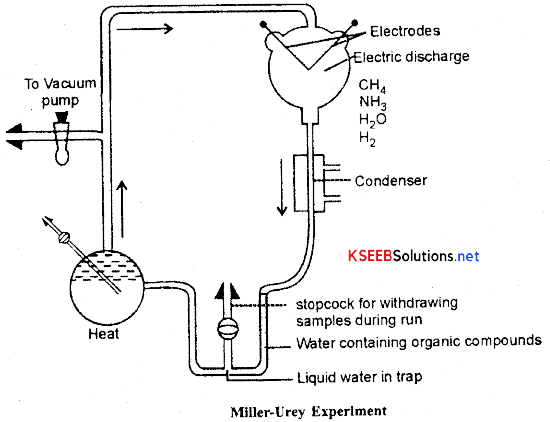
→ In 1953, Stanley Miller under the guidance of his professor Harold Urey conducted an experiment to investigate the conditions under which the simplest organic compounds were formed from the gases of the primitive .earth. Miller designed a glass apparatus called “Spark-discharge apparatus” to conduct the experiment: Spark discharge apparatus is roughly rectangular in shape with a Spark discharge chamber, water boiler, U-trap condensers all of which were connected by a rectangular side tube as shown in the diagram. The side tube is connected to the vacuum pump or stop cock, water was taken in the round bottom flask and the entire apparatus was evacuated to remove the free molecular oxygen. A mixture of gases like methane, hydrogen, and ammonia in the ratio of 2:1 : 2 by volume were passed into the apparatus.
→ The water in the round bottom flask was boiled to produce steam which was circulated clockwise in the apparatus. The spark discharge chamber contained two tungsten electrodes which were connected to a sparking coil that produced continuous discharge of sparks which served as sources of energy similar to lighting of the primitive Earth. The convectional current created by the circulation of the steam, carried the gases across the electrodes. The cooling jacket or condenser present below the sparking chamber, condensed the steam and the contents were collected in the U-trap.
→ When the products were analyzed it was found that there were a number of simpler organic compounds such as amino acids, acetic acid, propionic acid etc. The acids formed were alanine, glycine, aspartic acid, glutamic acids etc. Formation of amino acid is an important step in the origin of life. This Miller’s experiment provided the Vital proof that organic compounded can be formed form simple inorganic molecules under the conditions that existed on the primitive earth. This proves the origin of life from chemical substances.
![]()
Organic Evolution: (Evolution of Life Forms – A Theory)
→ Living organisms show variations. Variations are the difference between the parents and the offsprings. These variations form the basis for organic evolution. The term evolution is derived from Latin ‘e’ means “out” and “Volvo” means “roll”. Evolution literally means ‘opening up’ or unfolding or rolling out. Charles Darwin described evolution as “descent with modifications which means that the present day organisms have descended with adaptive modifications from simpler and more primitive forms of the past. Thus organic evolution may be defined as a slow, gradual and continuous change from the simpler organisms of the past to the present day more complex forms.
→ The evolution of stars planets and chemical compounds in the universe is generally called inorganic or geologic evolution.
Geological history of Earth:
- A common conclusion reached is that the earth is just not thousands of years old as was thought earlier, but billions of years old.
- The geological time scale is divided into eras, periods and epochs.
- Rocks are formed by sedimentation and a cross- section of the earth’s crust indicates the arrangement of the sediments over the long history of earth.
- Different sediments (of different ages) contain different life forms, which probably become extinct during the formation of the particular sediment.
- Certain organisms (like dinosaurs) have become extinct.
- Those found towards the upper layers resemble modem organisms, while others in the deeper layers were the simpler and primitive forms.
Evidences for evolution: Evidences for evolution come from
(a) Palaeontology,
(b) Embryology,
(c) Comparative anatomy and morpholoy,
(d) Molecular homology and
(e) Biogeography.
(a) Palaeontology:
Fossils found in the rocks support organic evolution.
A study of fossils from different sedimentary layers indicates :
- The geological time period in which the organisms existed.
- Life forms varied over time and certain life forms are restricted to certain geological time -spans.
- New forms of life have appeared at different times in the history of Earth.
![]()
(b) Embryology:
Based upon the observation of certain common features during embryonic slugs of all vertebrates, Ernst Haeekel proposed biogenetic law; it stated that ‘ontogeny, recapitulates their evolutionary history (Phylogeny).
Two striking similarities among the embryos of vertebrates are as follows:
- All vertebrate embryos develop a row of gill slits, but they are functional only in fish and not found in any other vertebrates.
- Notochord is present in all vertebrate embryos.
But this proposal was disapproved by Ernst Von Baer; he noted that embryos never pass though the adult stage of other animals.
(c) Comparative anatomy and morphology:
Comparative anatomy and morphology shows both similarities and differences among the present day organisms and those existed long before.
(i) Homology: Homology is the relationship among organs of different groups of organisms, that show similarity in the basic structure and embryonic development, but perform different functions.
→ Homology of organs of different organisms indicates their common ancestry.
→ Homology is found in the bones of forelimbs of whales, cheetah, birds, amphibians and humans; they have similar basic anatomical structure with the bones humerus, radius, ulna, carpals, metacarpals and phalanges.
→ Other examples are the hearts and brains of vertebrates.
→ Among plants, the thorns of Bougainvillea and tendrils of Cucurbita represent homology.
→ Homology or homologous organs is/are the result of divergent evolution, i.e., the evolutionary process where the same structure develops along different directions due to adaptations for different needs.
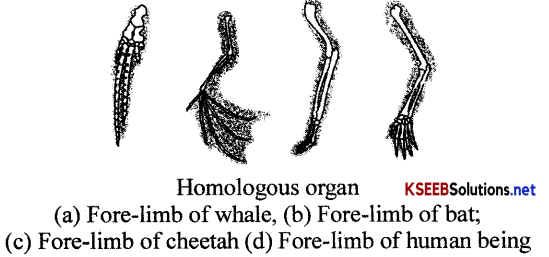
![]()
(ii) Analogy:
Analogy is the relationship among organs of different groups of organisms performing the same function, irrespective of structural or anatomical differences.
Some examples of organs showing analogy are;
- Eyes of octopus and those of mammals.
- Wings of a butterfly (insect) and those of birds.
- Flippers of whales or dolphins and those of penguins.
- Tubers of sweet potato (root modified) and those of potato (stem modified).
Analogy is the result of convergent evolution, i.e., the evolutionary process, where anatomically different structures in different groups of organisms evolve towards the same function. It is the similar habitat conditions that have selected similar adaptive features in different groups of organisms, towards the same function;
(iii) Vestigeal organs:
The organs which are reduced and non-functional in some and well developed and
functional in others are known as vestigeal organs.
eg. vermiform appendix, plica semilunaris, earmuscles etc.
(iv) Atavism:
It is the sudden reappearance of ancestral characters which has completely disappeared or reduced, eg. Appearance of small tail in babies, ability to move the pinnae.
(d) Molecular Homology:
Molecular ‘homology refers to the similarities in the, biomolecules of different groups of organisms.
The sequences of nucleotides in nucleic acid and many proteins are similar in apes and humans.
The biochemical similarities point to the same/common ancestry of diverse organisms.
(e) Biogeography:
The differential geographical distribution of different groups of organisms also indicates common/shared ancestry in that restricted region.
Habitat isolation has probably restricted these organisms to particular geographical regions on the Earth.
Mechanism of Evolution: There are plenty of evidences in support of organic evolution but the mechanism of evolution has been interpreted in different ways by different scientists. As a result of this, there are many theories to explain the mechanism of evolution like
- Use and Disuse theory of Lamarck (Lamarckism)
- Theory of natural selection by Darwin (Darwinism)
- Mutation theory by Hugo De varies
- Neo Darwinism
- Neo Lamarckism
![]()
Theory of natural selection by Darwin or Darwinism:
Charles Darwin (1809 -1882) known as the Father of evolution, was born on February 2,1809 in Shrewsbury, England. In 1831, he got an opportunity to join the British Cruiser H.M.S. Beagle as a naturalist. This voyage lasted for nearly 5 years, during which Darwin visited Galapagos island and several other countries and collected plants, animals and fossils. After his return, he extensively studied his collection and finally published a book “The origin of species by natural selection in 1859. Thus Darwin concluded and postulated a new theory “The theory of natural selection or Darwinism” which is based on the following important principles.
- Prodigality of production or overproduction.
- Struggle for existence.
- Variations.
- Survival of the Fittest.
- Natural selection.
- Speciation or origin of new species.
1. Overproduction or prodigality of production: According to Darwin, under ideal conditions each organism has the ability to produce offsprings in large numbers. But usually in nature, such large numbers are not reached due to a number of factors such as shortage of food, diseases, accidents, ageing, natural calamities (environmental struggle) etc.
Though there is enormous fertility in living organisms, yet the number remains constant. For e.g : A female elephant which is the slowest breeder becomes sexually mature at the age of 30 and can reproduce on an average 6 young ones during its fertile period. If all these young ones survived and reproduced in their turn, there would have been nearly 19 million elephants in about 750 years of time span.
An ostera (oyster) produces as many as 60-80 million eggs per year. If all these were to survive, the ocean would be full of oysters only.
The fruit fly, Drosophila takes 10-14 days to give rise to a new generation. A single female lays as many as 200 eggs. If all of them hatch and survive, the offsprings of a pair of fruit flies would be about 20 million in about 40-45 days.
2. Struggle for existence : Overproduction leads to the competition among themselves for food, shelter and mating because of which a few more may be eliminated. The competition may be intraspecific i.e., between the individuals of the same species or interspecific ie., between the individuals of different species. The struggle for existence acts as a natural check against increase in the number of individuals on a large scale.
3. Variations: The everlasting competition among organisms compelled them to change according to the conditions so that they can utilize the natural resources and can survive successfully. Variations are the differences in characters between the parents and the offsprings. Differences are found in eye colour, hair colour, shape of the nose, ears, size etc. No two organisms are identical in nature unles^they are homozygotic twins. According to Darwin, variations are the raw materials for evolution, where variations may be useful, harmful or neutral but Darwin never made a distinction between heritable and non heritable variations. He also never gave any reasons for the occurrence of variations.
4. Survival of the fittest: In the struggle for existence, only those organisms which have useful or favourable variations survive. Harmful or unfavourable variations make the organism unfit in the struggle for existence and will lead to their extinction. Individuals with useful variation will have better chances of mating, reproduction or passing the variations to the next generation. In this way, the more fit or the fittest will survive and reproduce, while the unfit individuals die. This is known as survival of the fittest.
5. Natural selection: The process of nature which selects the organisms with useful variations and eliminates the organisms with unfavourable variation is called natural selection. Thus the process of natural selection acts a selecting force.
6. Speciation or origin of new species: Darwin concluded that as a result of struggle for existence, variability and inheritance, successive generations tend to become better adapted to their environment. These adaptations are preserved and accumulated in the individuals of the species forming new characters and ultimately leading to the origin of new species. This process of formation of a new species by organic evolution is called speciation. As natural selection continues, the difference become more pronounced to mark off the successive generations as separate species. Thus the new species of organisms become markedly distinct from their ancestors.
![]()
Darwin explained the survival of the fittest and natural selection by giving the example of Giraffe. Neck of olden day giraffee was short when compared to modem giraffe. But when giraffe population increased there was scarcity of grass on the ground. As there was a severe competition for grass, they had to reach for the leaves of tall trees. Naturally giraffe with long neeks and long legs had an advantage over’those with short legs and short necks. The long necked giraffe had better chances of survival. They fed, reproduced and became abundant. On the other hand short necked and short legged giraffes starved and gradually became extinct. Thus, according to Darwin, nature selected the long necked giraffe. This proves the natural selection theory.
Examples of natural selection: (Evidences from Natural Selection): The modem day evidence for evolution and its mechanism by natural selections is provided by the following examples.
(a) Industrial melanism in peppered moths: Before 1840 ie., before the industrial revolution in England there was the British peppered moth, Biston betularia in abundance. This moth was speckled i.e., grey with dark pepper like spots on the wings. There were also dark or melanic forms of Bistort carbonaria but they were extremely rare. Before industrialization the tree trunks were all covered with grey speckled lichens. This provided good camouflage or matching background for the peppered moths from predatory birds like robbins. Peppered variety formed 99% and the melanic variety formed 1% of the moth population.
In the late 1850s, due to industrialization, the pollutants released from the industries killed or dried the lichens and darkened the tree trunks by black soot emitted by factories. As a result the peppered moths fell prey to predators because they could be easily seen than the black mutant moths (melanic forms) which began surviving better than the grey-coloured moths. Due to industrial smoke now 99% of moths are of the black variety, proving the point of natural selection and survival of the Attests. This indicates the natural selection eliminated the gene for light colour (harmful or favourable variation). The phenomenon was observed by a group of scientists led by Dr. H.B.D Kettlewell of Britain, R;A. Fischer, E.B Ford etc.
(b) DDT resistance in mosquitoes: Way back in 1950’s the mosquito population carrying Malaria and Filaria was controlled by extensive use of DDT (Dichloro, biphenyl trichloro ethane) which reduced the incidence of the disease successfully. Later in 1970’s when Malaria reappeared, DDT was found to be ineffective. This is known as the resistance of the mosquitoes to DDT. This happened because in the early years when DDT was used nearly all mosquitoes got killed but a few survived as they had the gene for DDT resistance. Gradually such mosquitoes increased in number and populations of mosquitoes arose from this resistant variety (natural selection).
Demerits:
- Darwin could not distinguish the heritable and nonheritable variations.
- He could not explain the origin and arrival of variations.
- Darwinism cannot explain cooperation and altruism present in the animals like bees and wasps.
- Darwinism cannot explain the existence of complex and most specialized organs like electric organs in Ray fishes eyes in the vertebrates etc.
- Darwinism cannot explain the presence of vestigial organs.
Artificial selection:
- Man has domesticated many wild animals and plants.
- He has also selected many plants and animals and carried out intensive breeding programmes to raise new varities of plants and animals for agriculture, horticulture, sport or security.
- He has raised a number of high-yielding breeds of animals (like cows, buffalo, poultry bird etc.) and crops (like varieties of wheat, rice, maize, pulses, etc.)
![]()
Adaptive Radiation:
- Adaptive radiation is an evolutionary process in which an ancestral stock gives rise to new species in a given’geographical area, starting from a point and literally radiating to other geographical areas or habitats.
- e.g., I. Darwin’s finches.
These were small black birds which Darwin observed in Galapagos island
There were many varieties in the same island. - He reasoned that after originating from a common ancestral seed-eating Stock, the finches must have radiated to different geographical areas and undergone adaptive changes, especially in the type of beak.
- Living in isolation for long, the new kinds of finches emerged that could function and survive in the new habitats.

Australian marsupials:
- A number of marsupials (pouched mammals) each different from the other, evolved from an ancestral stock within Australia.
- When more than one adaptive radiation appeared to have occured in an isolated geographical are With different habitats, it can be called as convergent evolution.
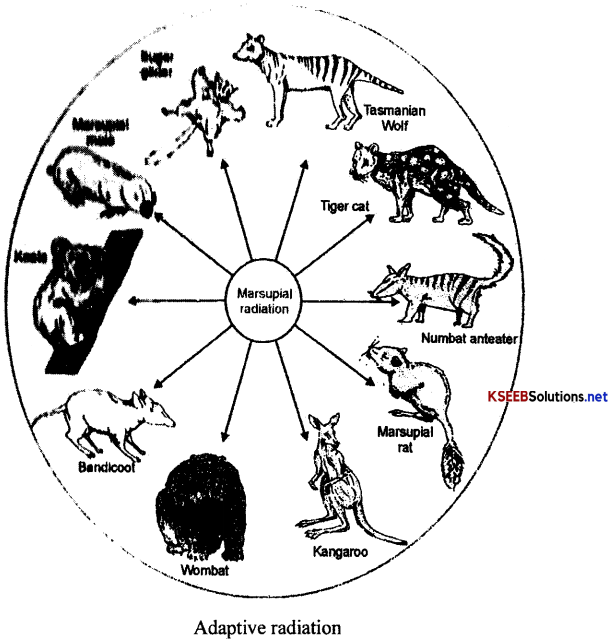
Placental mammals of Australia show parallel evolution as they have evolved from other marsupial mammals, each of which closely resembles and looks similar to a corresponding marsupial; a few examples are mentioned in the table.
Parallel Evolution of Australian Marsupials and Placental Mammals:
| Australian Marsupial | Placental Mammal |
| 1. Marsupial mole | Mole |
| 2. Numbat (banded anteater) | Anteater |
| 3. Marsupial mouse | Mouse |
| 4. Spotted cuscus | Lemur |
| 5. Flying Phalanger (sugar glider) | Flying squirrel |
| 6. Tasmanian Tiger cat | Bobcat |
| 7. Tasmanian Wolf | Wolf |
![]()
Lamarck’s Theory of Evolution:
- According to Lamarck, the evolution of life forms had occured by the use and disuse of organs.
- Organs that are used more develop more while those that are not used, becQme vestigeal in the long run.
- The character/adaptation developed by an organism during its life time is passed on to the progeny.
- He gave the longneck of giraffe as an example. According to him, it is an outcome of the attempt to stretch their neck continuously to eat leaves from tall trees.
- As they passed on this acquired character of long neck to succeding generations, giraffes came to acquire long neck over a long period of time.
Mutation theory by Hugo De Vries (1848-1935):
Hugo De Vries (Father of mutation) in 1901 proposed the mutation theory. De Vries was a Dutch botan ist who worked on the even ing primrose plant Oenothera lamarckiana. He conducted breeding experiments on these plants, Among the numerous plants he observed, he found around 800 plants with characters distinct for the others with reference to stature (height) size, texture of leaves, size of seeds, floral characters etc., plants with distinct features were different enough to be treated as new species he called them as sports.
Some of the distinct evening primrose plants were,
Brevistylis: Plants with short styled flowers.
Laevifolia: Leaves with smooth texture.
Nanella: Broad leaved plants with a Short stature. Finally a new type much longer than the original type called gigas was produced.
The generation of variations is a common occurrence in Oenothera. De Vries termed these variations as mutations and plants that underwent mutation as mutants.
From his studies on oenothera plants, De Vries proposed the mutation theory to explain the process of speciation (formation of new species) according to mutation theory “new species evolve from the earlier species by sudden heritable changes in the characteristics of individual members”. Some of his conclusions are,
1. The first individual showing a mutation is called a mutant. It is pure breeding and transmits its mutation to its progeny and this gives rise to a new species.
2. All organisms have a tendency to mutate but the rate of mutation varies from time to time depending on the environmental and physiological conditions.
3. Mutationsare indeterminate. They may be useful (progressive) or harmful (retrogressive) some time lethal.
4. Mutations occur suddenly to generate new species which differ greatly from their parental types. Hence there all no intermediary steps for gradual evolution in speciation or evolution by mutation is a rapid process. This single step large mutation is known as saltation.
6. The mutants which are the products of mutation come under the influence of natural selection.
He is the author of the book “Species and varieties.-Their origin by mutation”.
There are numerous evidences to show the occurrence of mutations in nature. Some of the examples are,
(a) The mutant white eyed fruit fly which got developed by the mutation of a red eyed fruit fly (Drosophila melanogaster)
(b) The occurrence of albinos among normal populations of humans and other animals.
(c) The Ancon variety of sheep with short legs which suddenly appeared in a population of normal long legged sheep in England.
![]()
Demerits or Criticism of mutation theory:
- Study of Morgar and Muller indicated that mutations are small changes and not comparable to , changes explained by De Vries.
- Generally mutations are recessive and do not express. But De Vries mutations expressed.
- Mutations alone do not cause the form of anew species.
- Mutations cannot explain the evolution of flightless birds and the like.
- Speciation by mutation is a very slow process.
- Mutations are not common in many plants and animals.
- Hugo de Vries mutations were chromosomal changes but not at the level of genes.
- Mutation theory is not accepted, but mutations are considered as raw materials of evolution.
- Hugo De Vries was one of the scientists who independently rediscovered and confirmed the laws of heredity as presented by Gregory Mendel.
Neo Darwinism or Synthetic Theory of Evolution or Genetic Theory of Natural Selection or Biological Evolution:
→ This is also called as modem concept of organic evolution. The concept of Neo-Darwinism is a view of evolutionary theory arising out of a combination of Mendelian genetics, mutation by De Vries with Darwinism. A group of eminent scientists like Dobzhansky, De Vries, Weisman, Fischer, J.B.S Haldane, H.J. Mulles, Simpson, Gold Schmidt, Sewall Wright, Huxley etc., constituted a group called Neo-Darwinism school of thought
→ According to Neo-Darwinism, the gene pool in sexually reproducing organisms is the focal point to interpret evolutionary changes brought about by mutation, gene flow, genetic drift, genetic recombination, chromosomal aberrations, natural selection and isolation.
Darwinian concept vs Neo Darwinian concept:
1. According to Darwinism, rapid rate of reproduction leads to struggle for existence during which useful variations help in the survival of an organism picked up by natural selection. The accumulation of such variations from generation to generation is responsible for the origin of a new species while according to Neo-Darwinism change in the gene frequency is evolution.
2. According to Darwinism, source of variation was not explained. The somatic and germinal variations were not differentiated and were considered as heritable while Neo-Darwinism
differentiates somatic and germinal variation and has understood the principle of inheritance.
3. According to Darwinism, evolution operates on an organism while Neo-Darwinism believes that evolution operates on a gene pool.
4. According to Darwinism, natural selection operates through survival of the fittest, while in
Neo-Darwinism natural selection operates the differential reproduction and comparative reproductive success.
5. According to Darwinism, the survival of the fittest was explained but not the arrival of the fittest while Neo-Darwinism explains the arrival of the fittest.
Neo-Darwinism can be understood by two major factors, namely gene pool and gene frequency.
Gene pool is defined as the sum total of all the genes occurring in a large population of sexually reproducing organisms.
![]()
Gene Frequency is the frequency of an allele of a gene in a gene pool or the ratio of different I alleles of a gene in a population.
Hardy Weinberg Law or Hardy Weinberg Equilibrium: This law was proposed by British Mathematician Hardy and German Physicist E. Weinberg. The Law states that “Gene frequency of a Mendelian population remains constant through generations unless there are chromosomal | aberrations, mutation etc to alter the genetic equilibrium”.
This law describes that when the population is in equilibrium there is no evolution. Evolution occurs only when the equilibrium is altered. Mendelian population is a closely interbreeding group of organisms sharing common gene pool.
Following are the conditions responsible for hardy Weinberg equilibrium.
- The law operates only on a large sexually reproducing population.
- In this population mating has to be random.
- The allele frequencies of male and female should be same.
- The allele genotypes are equal in viability and fertility.
- Evolution factors like mutation, migration and selection should not occur. So evolution occurs only when the equilibrium is altered.
Sources of variations as evolutionary forces: Variations are the difference in characters between the parent and the offsprings. In nature, variations could be brought about by various evolutionary forces such as,
(a) Sexual reproduction is the fusion of male gamete with the haploid female gamete to form a diploid zygote process of mixing or reshuffling of reproduction. In all sexual ly reproducing organisms gametes are formed as a result of meiosis. During meiosis an exchange of genetic material between the non-sister chromatics of the bivalent takes place. This provides new combinations of genes which bring about new characters in the offsprings.
(b) Genetic drift or Sewall Wright effect is defined as “Random changes in gene frequency in a small interbreeding population happen purely by change”. As a result of genetic drift, some genes may be reduced or increased in frequency. Some of them may even be lost by chance. This genetic drift leads to the fixation or loss of certain genes irrespective of their adaptive value.
Founder effect:
Sometimes the change in allele frequency is so different in the new sample of population that they become a different species. The original drifted population becomes founders and the effect is called Founder effect.
(c) Gene flow is defined as the transfer of genes between two interbreeding populations which differ genetically. Migration and hybridization are the chief sources of gene flow. ‘The gene flow pattern decides the gene frequency of a population.
(d) Mutation is a sudden permanent change brought about in the genetic make up of an organism which is heritable. There are two types of mutations namely gene mutation and chromosomal mutation.
(i) Gene mutation or point mutation is that any change in the sequence of nucleotides of a DNA molecule results in a change in the triplet codons or genes. For e.g: Due to mutation in the gene, one of the amino acid called glutamic acid is replaced by valine in human RBC cell resulting in a genetic disorder called sickle celled anaemia.
(ii) Chromosomal mutation or chromosomal aberration is the visible change in the structure of the chromosomes or in the total number of chromosomes due to deletions, duplication, inversion and translocation per cell, e.g: In humans there are 46 chromosomes (44 autosomes 2 sex chromosomes ). The deletion of one ‘X’ chromosomes results in Turner’s syndrome (sterile female) (44 + X). Addition of one extra ‘X’ chromosome results in Kline felters syndrome (44 A + XXY) (male with feminine characters)
Mutations may be caused due to errors during DNA duplication or due to environmental factors like chemicals, radiation etc. If these mutant genes are in the somatic cell they may not be of evolutionary significance. If they are in the germ cells they are passed on–to the next generation and are of evolutionary significance. Hence mutations are considered as the raw materials for evolution.
(e) Isolation is the separation of a single interbreeding population into subunits by some barriers which prevents interbreeding. Isolation may be geographic, spatial, biotic or reproductive.
Reproductive isolation: Restricts gene flow between discreet populations due to interspecies sterility. This results in the formation of a new species.
Geographic isolation: Separates previously interbreeding population by geographic or physical barriers such as a river, desert, a mountain range or the sea. Each subunit will become genetically different and evolves into a distinct Species. Thus isolation leads to speciation or origin of a new species.
![]()
Natural Selection:
- Natural selection is the process in which heritable variations enabling better survival are enabled to reproduce and leave greater number of progeny (with more fit individuals).
- Depending upon the traits favoured, natural selection can produce one of the three following effects.
- Stabilisation, in which more individuals acquire mean character value, i.e., variation is much reduced.
- Directional change, in which more individuals acquire value other than the mean character
- Disruption, in which more individuals acquire peripheral character value at both ends of the distribution curve.
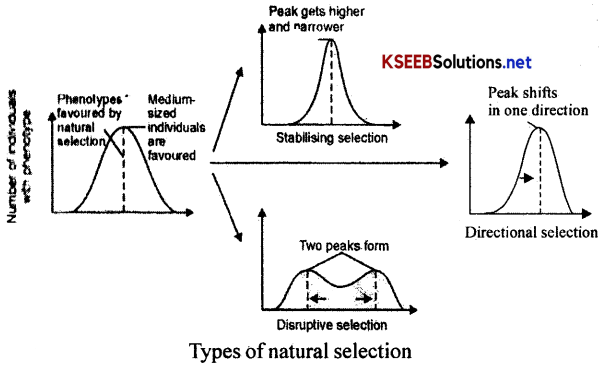
A brief account of evolution.
History of evolution of animals:
- About 2000 million years ago, the first cellular, forms of life appeared on the earth.
- Slowly these single-celled organisms evolved into multiclellular organisms.
- Invertebrates were formed around 500 milion years ago.
- Jawless fish must have evolved around 350 million years ago.
- At around the same time, fish with stout and strong fins, that could move on land and go back to water, must have appeared.
- The colecanth or lobefins were the ancestors of modern day frogs and salamanders.
- These amphibians evolved into reptiles that lay thick-shelled eggs which do not dry up in the Sun. This made the reptiles more sucessful than amphibians.
- In the next 200 million years or so, reptiles of different shapes and sizes dominated the earth.
- Some of these land reptiles moved back into water to evolve into fish-like reptiles (Ichthyosaurs), at around the same time(200 million years ago).
- The land reptiles, i.e., dinosaurs, suddenly disappeared from the earth (mass extinction) about 65 million years ago, while the small sized reptiles continue to exist even today.
- When the reptiles disappeared, mammals started dominating the earth.
- The first-mammals like horse, hippopotamus, rabbit, bear, etc., in South America, but when South America joined North America (in the continental drift), these animals were over-ridden by the fauna of North America.
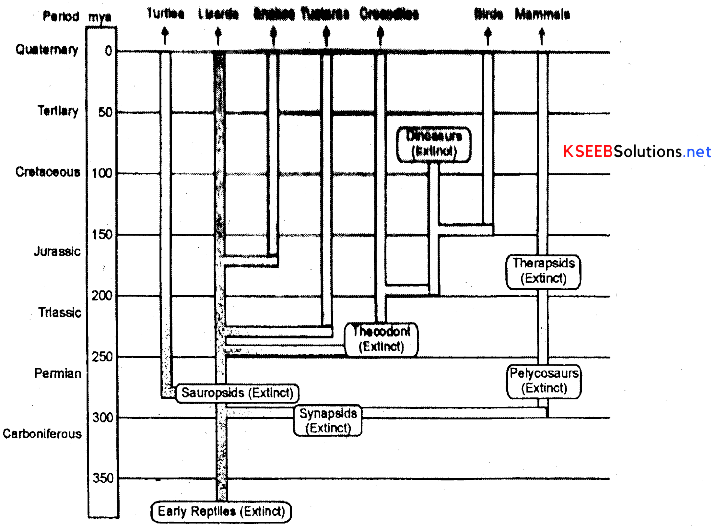
- Australian land mass remained isolated and the pouched mammals survived as there was no competition from any other mammal.
- Evolutionary history of horse, elephant, dog and man are all known.
![]()
History of evolution of plants:
- Some of the single-celled organisms that appeard 2000 million years ago had pigments to capture solar energy and release oxygen, by the process of photosynthesis.
- Bryophytes were the first plants to colonise lands. (Plants colonised the land much before animals).
- Sea weeds and few plants existed around 320 million years ago.
- About 200 million years ago, giant ferns (Pteridophytes) were present, but they all got buried under to form coal deposits slowly.
- Herbaceous lycopods and arborescent lycopods evolved from Zosterophyllum of palaeozoic era.
- Psilophyton is the common ancestor for horsetails, ferns and gymnosperms.
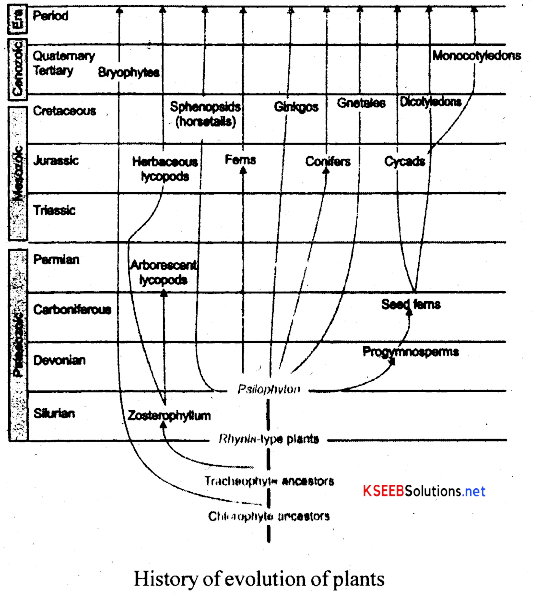
Evolution of Man:
- The common ancestor of apes and man was a primate dryopithecus, that lived 15 million years ago.
- At the same time, another genus ramapithecus, also existed.
- Both dryopithecus and ramapithecus were hairy and walked like gorillas and chimpanzees; Dryopithecus was more ape-like, but ramapithecus was more man-like and is the foreruner of hominid evolution.

(a) Skull of a modem man (b) Skull of a baby Chimpanzee (c) Skull of an adult Chimpanzee
The human evolution is as follows:
(a) Australopithecines:
- They probably lived 2 million years ago, in the East African grasslands.
- They had a brain capacity of 450-600 cc.
- They hunted with stone weapons but essentially ate fruits.
(b) Homo habilis:
- They were the first human-like beings, the hominids.
- They had a brain capacity of 650-800 cc.
- They probably did not eat meat.
(c) Homo erectus:
- Their fossils were found in Java (Java man) in 1981.
- They probably lived about 1.5 million years ago.
- They had a brain capacity of about 900cc.
- They probably ate meat.
![]()
(d) Homo sapiens (Primitive man):
- Their fossils have been found in the near East and Central Asia.
- They must have lived between 1,00,000 – 40,000 years ago.
- Neanderthal man (Homo sapiens neanderthalensis) had a brain capacity of about 1400cc.
- They used hides to protect their body and buried the dead.
- They moved across continents and developed into distinct races.
(e) Homo sapiens sapiens (Modern Man):
- Home sapiens arose during the ice age between 75000 – 10000 years ago.
- They spread all over the globe and learned to cultivate plants and domesticate animals.
- Pre-historic cave art developed about 18,000 years ago.
- Agriculture started around 10,000 years ago.
- Human settlements and civilisations started.